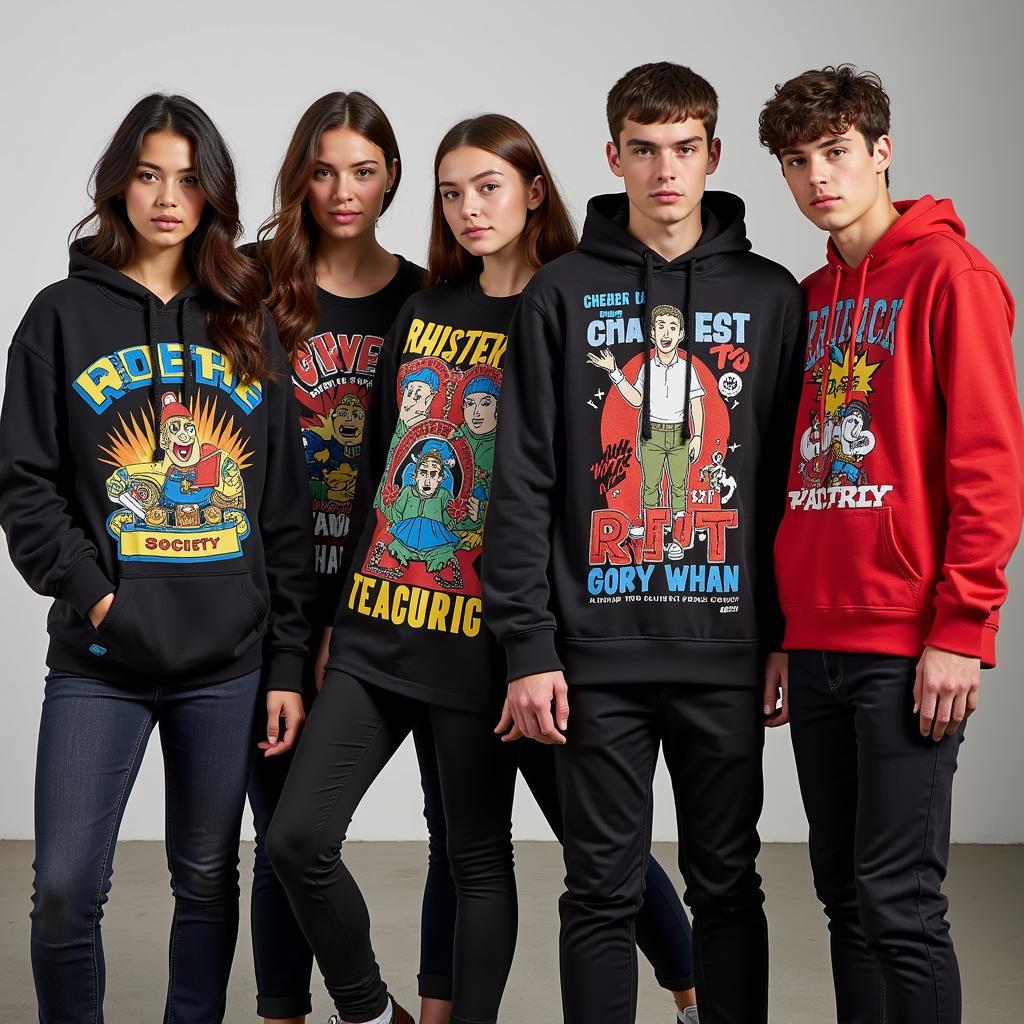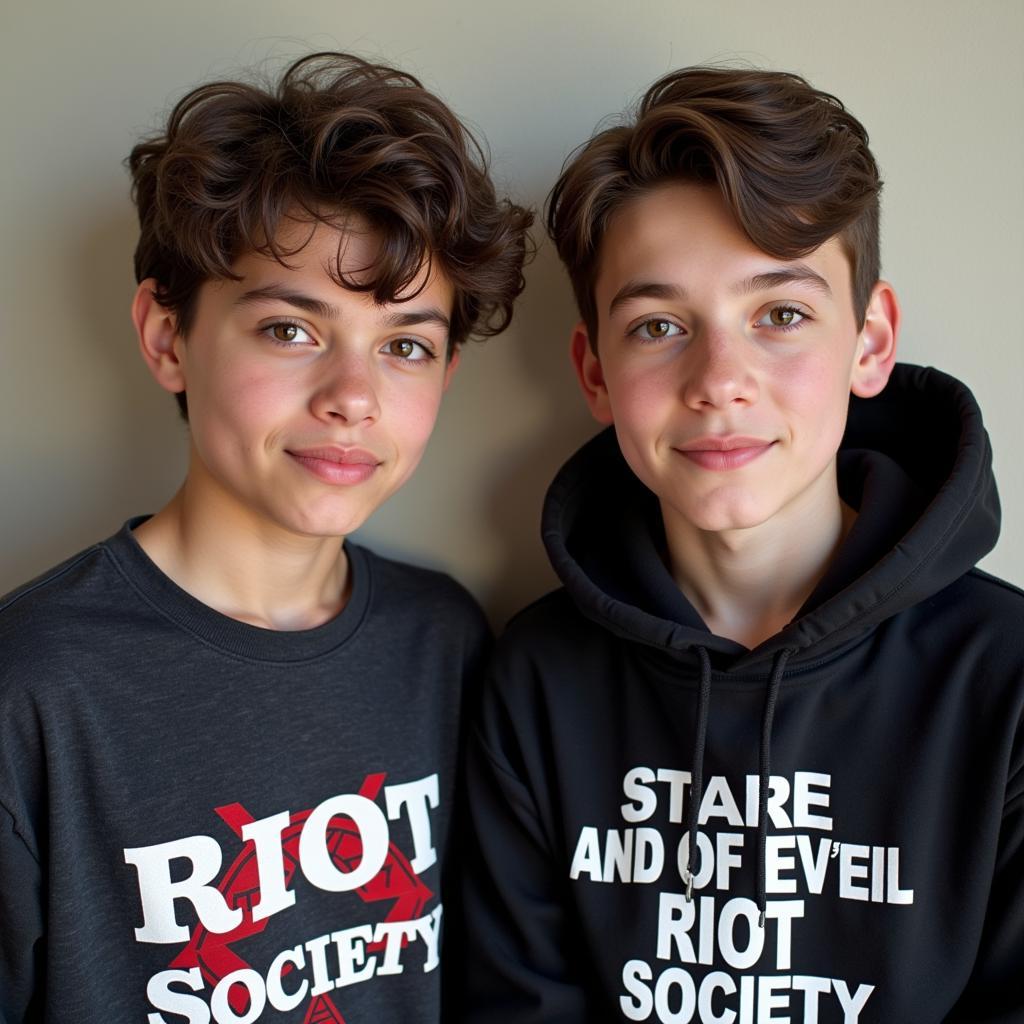“Riot Society Apparel” is more than just clothing; it’s a statement. But what exactly is that statement, and what lies beneath the surface of this popular clothing brand? This article delves into the multifaceted world of “Riot Society apparel”, exploring its cultural impact, the motivations of its wearers, and its potential connection to deeper societal issues.
Beyond the Fabric: Deciphering the Message of “Riot Society Apparel”
 Young adults wearing Riot Society apparel
Young adults wearing Riot Society apparel
Often adorned with bold graphics, provocative slogans, and unconventional designs, “Riot Society apparel” can be seen as a form of self-expression for young people navigating the complexities of modern life. For some, it’s a way to rebel against societal norms, to challenge the status quo, and to visually communicate their individuality. The brand’s aesthetic, often drawing inspiration from streetwear, counterculture, and underground art movements, resonates with those seeking an alternative to mainstream fashion.
However, this outward expression of rebellion can also be misinterpreted. The word “riot” itself carries weighty connotations, evoking images of unrest, chaos, and social upheaval. It’s crucial to examine whether wearing “Riot Society apparel” is truly an act of defiance or simply a fashion statement, devoid of any deeper meaning.
The Allure of Rebellion: Why “Riot Society Apparel” Appeals to Youth
 Teenagers using Riot Society clothing as a form of self-expression
Teenagers using Riot Society clothing as a form of self-expression
Adolescence is a period marked by self-discovery, a time when young people are forging their identities and seeking a place in the world. “Riot Society apparel”, with its rebellious undertones and nonconformist aesthetic, can be particularly appealing to teenagers grappling with these formative experiences.
- Desire for Belonging: Wearing clothing from a recognizable brand can foster a sense of community and belonging, connecting individuals with shared values and interests.
- Expression of Frustration: For some, “Riot Society apparel” might be an outlet for expressing frustration with societal pressures, injustices, or a perceived lack of control over their lives.
- Seeking Attention: The bold and often provocative nature of “Riot Society apparel” can be a way for teenagers to stand out from the crowd and assert their individuality.
It’s important to note that these motivations are not mutually exclusive, and the reasons behind wearing “Riot Society apparel” can be complex and multifaceted.
“Riot Society Apparel” and Social Commentary: A Deeper Look
 A group discussion about social issues and fashion choices
A group discussion about social issues and fashion choices
While “Riot Society apparel” might be perceived by some as merely a fashion trend, it’s essential to consider its potential to spark conversations about deeper societal issues. The brand’s name itself invites reflection on the role of rebellion and dissent in a functioning society.
- Is “Riot Society apparel” a form of passive protest or a catalyst for meaningful dialogue about social change?
- Does wearing clothing with rebellious imagery translate into real-world action, or does it risk trivializing important social movements?
- How can we encourage young people to channel their energy and frustration into constructive forms of activism?
These are just a few of the questions that arise when examining “Riot Society apparel” through a sociological lens.
Navigating the Complexity: Encouraging Understanding and Empathy
Ultimately, understanding the motivations behind wearing “Riot Society apparel” requires empathy, open-mindedness, and a willingness to engage in meaningful dialogue. It’s easy to jump to conclusions or make assumptions based on outward appearances, but true understanding comes from listening to diverse perspectives and engaging in respectful conversations.
While “Riot Society apparel” might be seen by some as a symbol of rebellion or a passing fashion trend, it’s crucial to recognize that clothing choices are often deeply personal and can reflect a wide range of beliefs, experiences, and aspirations. By fostering understanding and empathy, we can create a more inclusive and compassionate world where young people feel heard, respected, and empowered to express themselves authentically.